|
On a Sunday afternoon this summer, I was idling at home browsing the YouTube on internet for entertainment. I found an episode of a film edited from Wu Cheng-En’s novel in the Ming Dynasty of ancient China, “Journey to the West”, one of the Four Great Classical Novels of Chinese literature. The work is widely known as “Monkey” in English-speaking countries. The episode of the film with a popular song in Cantonese ( 一生所愛 ) as background music, meanwhile a couple of young man and woman facing each other at arms-length and struggling against to hug each other to express their love. Like the metaphor put by Plato, “a charioteer controlling a pair of steeds of which one is noble and good of good stock, while the other has opposite character of his stock is opposite.” I remember a piece of the content of the song is about: … 苦海翻起愛恨 在世間難逃避命運 相親竟不可接近 或我應該相信是緣分 … It properly means: “… Love and hate flipping in the sea of bitterness, It’s hard to avoid sadness of fate in this secular world. Although in love, actually not available to approach each other, Or, I’ve to believe it is fate.” With background of sensational music and song, the Monkey suddenly crept into the soul of the young man conducting him to make a bear hug and to deep kiss the young lady. Even though the Monkey had left the soul of the young man alone, the man himself could deliver a promise of eternal love to the lady with confidence and passion. “Film is understood not only as a source of illustration or example for philosophical reflection on human existence, but also as an object of philosophical reflection” (WONG Kim-fan, 2014). Essence of the episode was protesting against the feeling of sin towards the wish of experiencing love. But I found it using the righteous mind of religious thinking approach unconsciously purified the mind-set of people in expressing their right of love. Later on, I started to query about why expressing love will stir up feeling of sin, just like the youth’s struggling in the episode. We can find that meaning of “sin” recapitulated in the Old Testament is mainly around deviation from the nature of life that gained from God. “Sin” is also a deviation from the target of life or abandoned oneself from the nature (Anselm Grun 2013). Jesus pointed to us “That which proceeds out of the man that defiles the man. For from within, out of the hearts of men, proceed evil thoughts … sins … covering … and foolishness. All these evil things come from within, and defile the man.” (Mark 7:20-23). In the Garden of Eden, Adam and Eve found they were not dreaming when they woke up, but they were naked! Therefore they disguised themselves with leaves as quickly as possible while their inner voice kept nagging “Guilty! Guilty!” The fact that Adam and Eve then knew they were naked showed that they had a conscience, which they got from eating the fruit of the tree of the knowledge of good and evil against God’s commands. Their conscience was activated when they sinned. Consciousness of sin needs to be understood and restored to its originally justified position (Fr. NG C.F. Robert 2000). God is the One we offend when we sin, and only He can provide a remedy for our sin and guilt. Coming back to the episode of the film, the young man had been inspired from soul to body to get rid of the indebted sin from inside. Finally he could restore his conscious of sin to its originally justified position, purified his mind-set and, found himself able to express his love in a righteous manner without hiding or disguising his conscience of love. But the happy ending of the episode can hardly conclude an answer for curiosity to get a deeper understanding of the youth’s changing from feeling of sin to expressing of love without reservation. It is however just an episode of a film, or just a script of drama with bias. I think. But in reality, people do change their mind and there should be a process of changing patterns under the principle of theories. Motivational Build-up Psychologist argued that biological forces are basic determinants of the behavior of most of the human beings of their time and the said biological forces are called “needs” or “drives”. By definition, “drives” are innate, biological determines of human behaviors that are activated by deprivation. Drives are however belong to reflect-action and of non-decision making or lower level decision making processing, which is different from goal seeking actions under decision making of consciousness. And motives are defined to be learned influences on human behaviors that lead people to pursue particular goals of particular values. It is the mind that ultimately takes the decisions about behaviors. Drives and motives are influencing decisions making of mind on human behaviors. Abraham Maslow (American psychologist) summarized his theory of motivation that human beings have seven innate needs: 1. Physiological needs, 2. Safety needs, 3. Love needs, 4. Esteem needs, 5. Self-actualization needs, and 6. Freedom of inquiry and expression needs, 7. The need to know and understanding. Maslow’s theory regarded the last two needs as essential prerequisites for the satisfaction of the first five sets of needs and, the first five sets of needs are organized in a loose hierarchy. Under the theory, people have an innate desire to work their way up the hierarchy. Ultimately, the experience of self-actualization stimulates the desire for more. 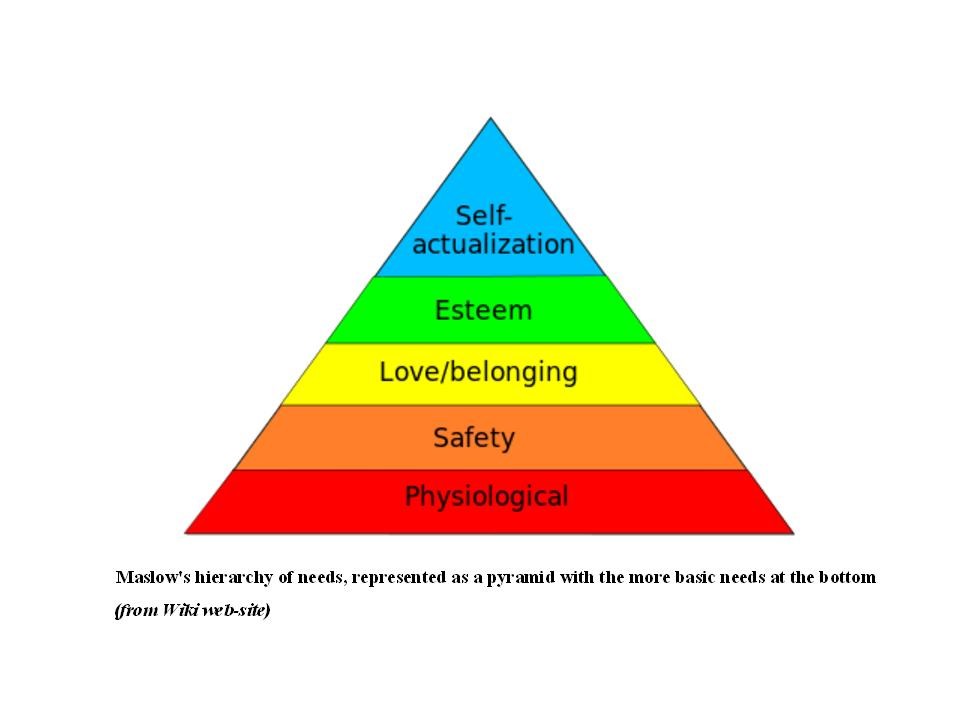
Richard Barret (British psychologist) based on Maslow’s hierarchy of human needs re-mapped out a value building model of human beings, called the “The Seven Levels of Personal Consciousness” reading from bottom to top. Associating with the illustration of “Ego-Soul Dynamic” development, the Seven Levels of Personal Consciousness could be classified into three categories, 1) the ego development, 2) the ego-soul alignment and 3) the soul activation. The “ego-soul alignment” acts as an imperative transformation platform (between ego development and soul activation) to get the ego of a person align with one’s own soul to pursue self-actualization and vision (in the society). The Seven Levels of Personal Consciousness and the Ego-Soul Dynamic development are illustrated as in the diagram below: 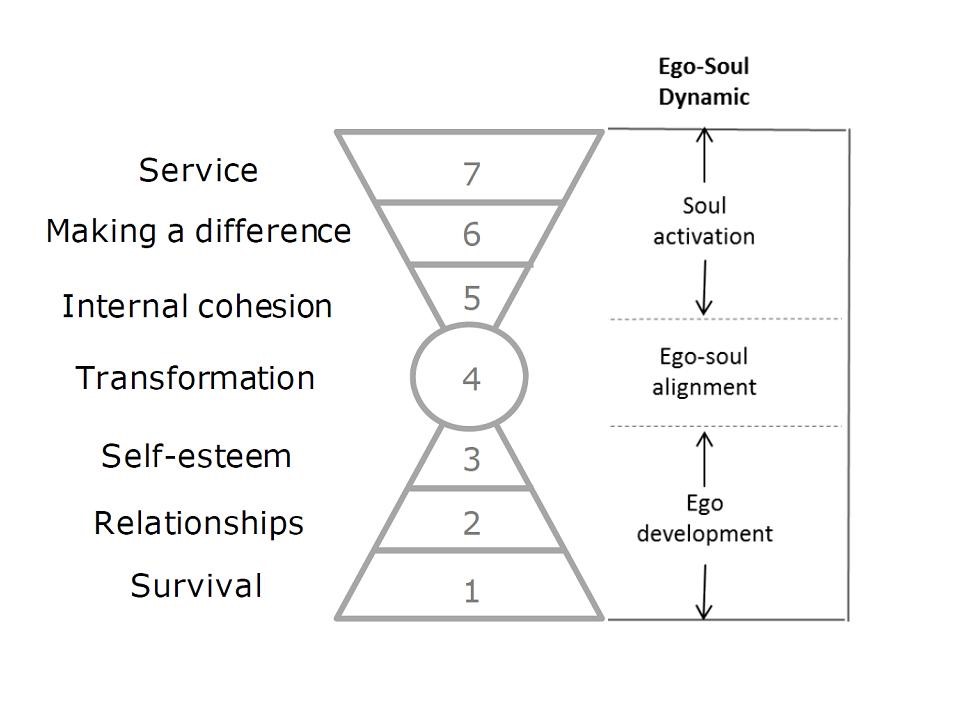
Richard Barret’s Seven Levels of Personal Consciousness and Ego-Soul Dynamic (from Wiki Web-site) According to Barret, the lower three levels of consciousness are “deficiency” needs and the upper three are “growth” needs. Human individuals incline to operate from full spectrum consciousness to manage complexity and adapt to all situations by balancing their needs of “deficiency” and needs of “growth”. For one’s decision making, the focus is on the fourth level of consciousness, which is a level of mind transformation. In which the subconscious is released and one can establish a sense of his own personality to manage deficiency needs, to choose to live by values and beliefs and to begin the process of self-actualization integrating into the needs of one’s growth. The Ethic Cycle Bernard Lonergan (Christian theologian) has presented in the preface of his book, Method in Theology that “… I have enjoyed the hospitality of Regis College, which has met all my needs and let me free to think and write without asking any service in return…” The decision approach that is written in the preface sentences was interestingly matched with the aforementioned decision making development models. In Lonergan’s Method in Theology, his vision has been developed into four levels of intentional consciousness (associating with corresponding level of human self-transcendence): 1. Level of Experiencing (being attentive) 2. Level of Understanding (being intelligent) 3. Level of Judgement (being reasonable) 4. Level of Deciding (being responsible) 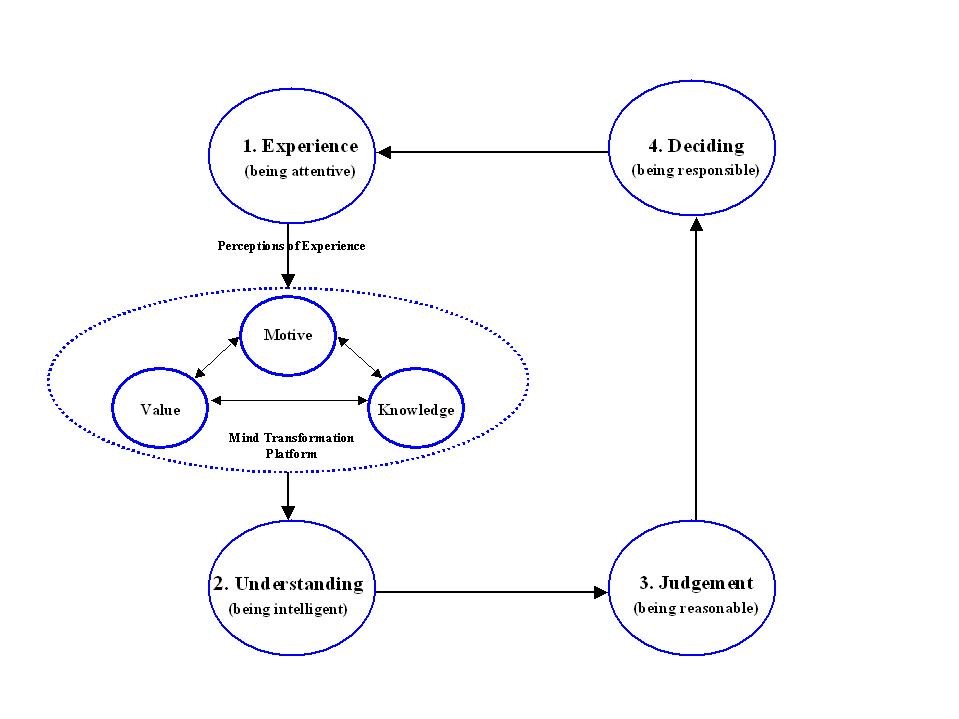
Objective Learning Cycle (Ethic Cycle) of Experience-Understanding-Judgement-Decision They are related to one another on the principle of sublation (i.e. higher levels perfect, go beyond but respect the integrity of lower levels) and can be viewed as an objective learning cycle (compared to the Deming Cycle of PDCA, plan-do-check-act). Among the four levels of intentional consciousness that can be developed with a “mind transformation platform” in between the Experience Level and the Understanding Level as illustrated in the aforementioned “Ethic Cycle”. Function of the “mind transformation platform” receives perception of factual experiences then goes through reasoning processing to finalize an understanding. In the reasoning processing, it will go through among one’s personal motive, knowledge acquired and believed values to choose a path in actualization an understanding to integrate into the needs of growth under his own soul activation. The goal is in the realization of true values and the criterion as a peaceful conscience. According to the study of Lonergan’s, the Method of Theology has been expanded into the Fifth Level, Religious Orientation (Religious Values) with human self-transcendence level of “Be In Love” (The Lonergan Institute online). The Moral Cycle Our conscience is our realization that what we might do or have done is good or not, but it is not the power of actual doing or the choosing (Saint Thomas Aquinas). Appropriate exercises of conscience, is called prudence. For Aquinas, conscience is the act of applying our knowledge of good and evil to what we do (or might do). So one needs to be free to act in accordance with what one knows to be the Divine order of things, or not with. We need to contact with God as living altitudes in order to meliorate contents of our conscience and acquiring true values in the living God. “It seems that men with mistaken consciences are caught in a trap, and cannot avoid sin” (Summa Theologiae, Ia-IIae, 19.6). For Lonergan, conscience is consciousness at the level of moral decisions and consciousness is an awareness of the subject associating with awareness of its activities. Hence it is an awareness of oneself as responding to value, making correct judgments of value, deciding and implementing these judgments. This awareness is present when the moral question arises, in the process of deliberating, in the decision, in the execution and afterwards. Underlying the values that a person holds and expresses is their general disposition or sensibility. Our values underlie our moral rules. Values only express what it is that we believe has value. The diagram in below, “Innate Human Moral Cycle” demonstrated the operation of conscience in judging one’s defined values system through the deliberation of Conscience, Sin and Consciousness to achieve the believed Value, which will be judged in Conscience again. Conscience is innate and can be meliorated through our free will in contact with God constantly. 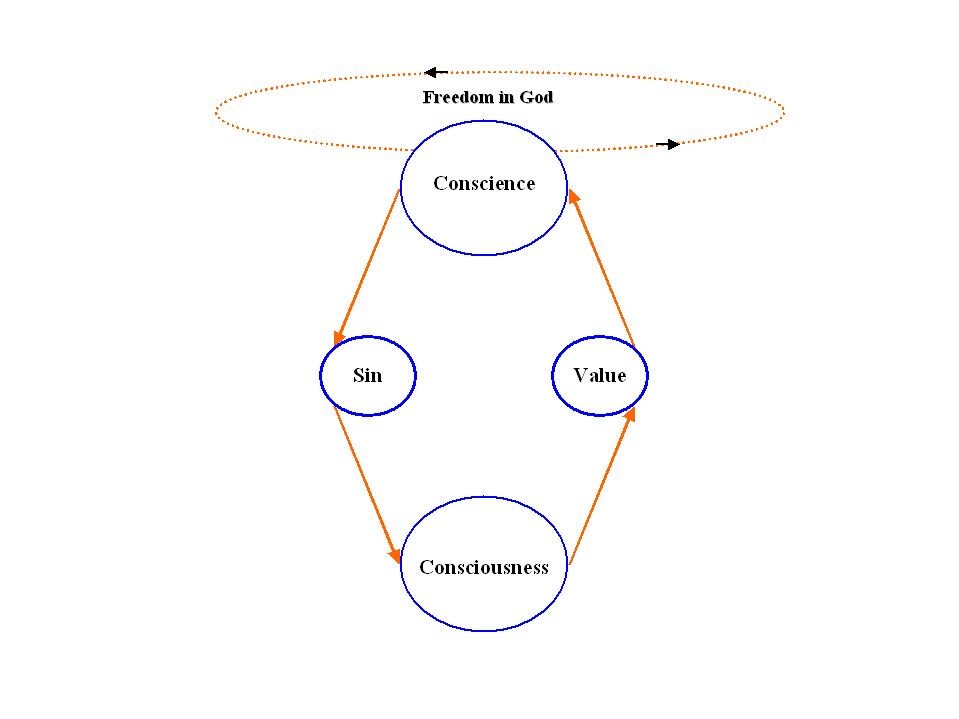
Innate Human Moral Cycle Judgement of Moral Cycle over Ethic Cycle Being a moral person is more than following accepted codes of conduct, whether business, religious, political, or simply holding a belief in the importance of ethics. It requires us to know how to make good moral decisions by using ethical standards and critical thinking and to be sensitive to the implications of our decisions. Moral decision-making often challenges us to evaluate ambiguous and incomplete information, and to develop sufficient skills to implement our moral decisions. The value system fostered in the innate human moral cycle can be a “Super-ego” in the value system being operated in the ethic cycle, judging the decision made under ethical standards and meliorating the final decision-making. Diagram in below demonstrates a process of combination of the moral cycle and ethic cycle in thinking of decision making. 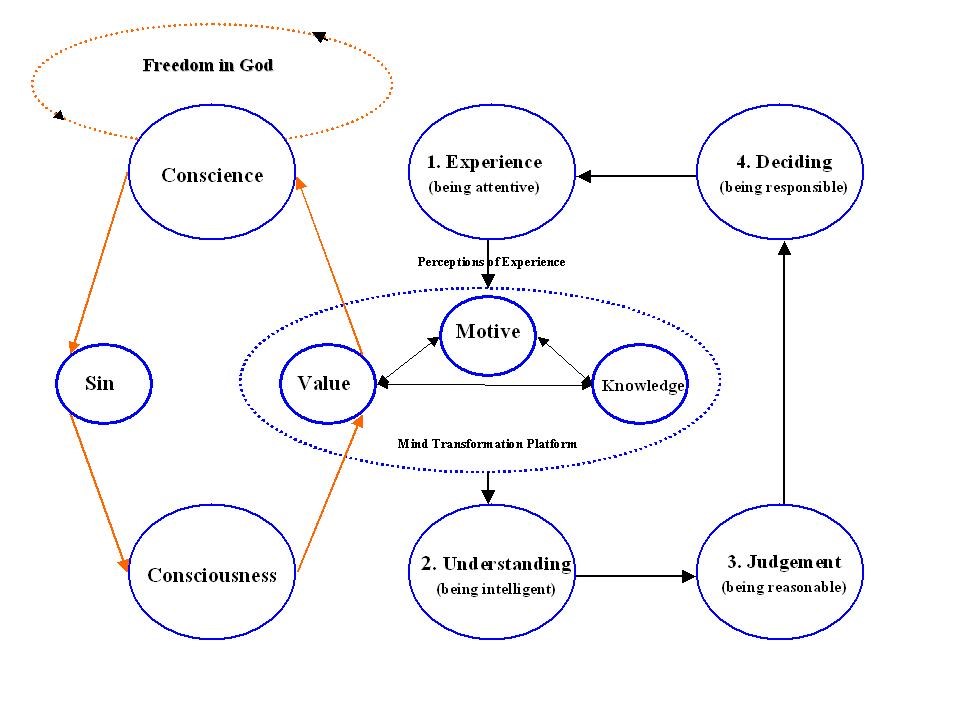
Combined Innate Human Moral Cycle and Learned Ethic Cycle in Thinking Process Conclusion In God, we have the power to act on freely chosen decisions to shape the world and ourselves through our decisions making. We possess a consciousness that enables us to consider our options and decide what to do. The dos and don’ts of the moral law are boundaries that enable people to exercise freedom in such a way that they develop their true potential. We should take on responsibility and are accountable for our decisions made. “But, of course, once we have sinned, it is impossible for us to give God the perfect life that we owe him, so we are left in the position of a debtor for the remainder of his existence” (St. Anselm of Canterbury). That will make us living in a life of insufficient. Jesus’ reply to the rich young man challenges him to not only give up his possessions but to give himself and become a follower of Christ: “If you wish to be perfect, go, sell your possessions, and give to the poor, and you will have treasure in heaven; and come, follow me.” (Matthew 19:21) The fundamental challenge of the moral life is to make us a gift to others. Moral rules and laws exist to prepare people to face that challenge. As Christians we live in the gap between the persons we are today and the persons we are called to become. The combined thinking function in operating our innate human moral cycle of God’s gift and the ethic cycle we learned in the secular world shows us that we can bridge that gap ourselves by giving freely in love under the freedom in God in search of true value. “Self-giving goes hand in hand with experiencing God.” References: Andrzej Huczynski and David Buchanan, Organizational Behaviour, Prentice Hall, 1991 Bernard Lonergan, Method in Theology, University of Toronto Press, 2013 Byran Magee, The Great Philosophers an Introduction to Western Philosophy, Oxford University Press, 1987 Conscience, Morality, Values (Teacher Guide), National Centre for Religious Studies Catholic Centre, NZL, 2014 Richard Barrett, What is Well-being?, https://www.valuescentre.com/ 2016 WONG Kim-fan, Philosophy, Film and Life 哲學、電影與人生, Philosophy, Film and Life-2014 吳信如, 你信什麼? 基督宗教與佛教的生命對話, 臺灣南與北文化出版社, 2013 吳智勳神父, 基本倫理神學, 香港思維出版社, 2009 傅佩榮, 西方哲學史, 臺灣聯經出版, 2016 傅偉勳, 西洋哲學史, 臺灣三民書局, 2000. 黃錦文神父, 神學導論(課堂講議), 聖神修院神哲學院, 2016 葉慶華神父, 人的哲學(課堂講議), 聖神修院神哲學院, 2016 趙復三(譯), 歐洲思想史, 香港中文大學出版社, 2003 http://plato.stanford.edu/about.html http://www.aquinasonline.com/Questions/conscience.htm http://www.lonergan.org/online_books/cronin/epilogue.htm |